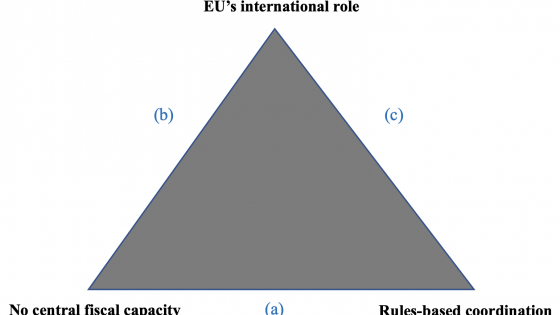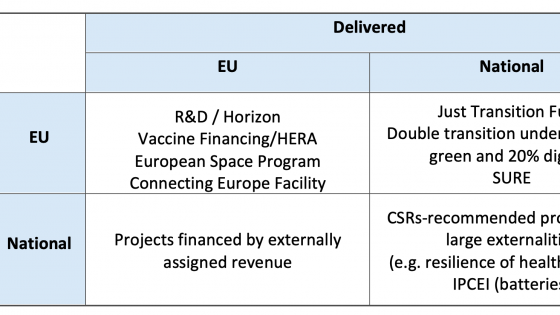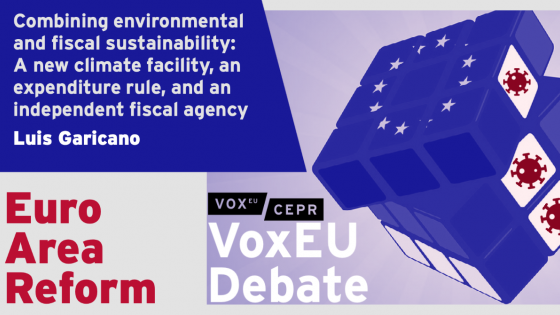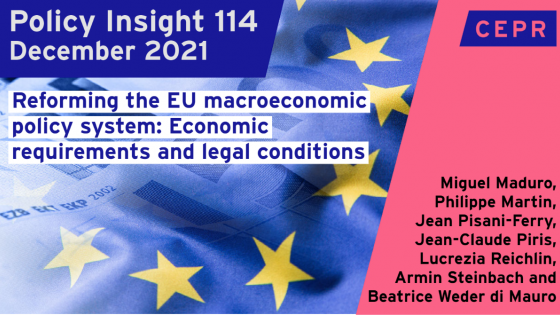The debate on the geo-economic role of the EU is encapsulated in the ‘open strategic autonomy’ formula; hence, it has mainly taken place in the realm of foreign policy and, as far as technological innovations and supply-chain issues were concerned, in the realm of industrial policy. In parallel, the debate on economic policy coordination in the wake of the EU response to the pandemic has centred on the implementation and the future evolution of NextGenerationEU (NGEU). It has mainly addressed the challenges in delivering the reform and investment commitments under the Recovery and Resilience Facility (RRF), the implications for the policy mix of a permanent central fiscal capacity, and the supply of European public goods (EPGs) (e.g. Buti and Papacostantinou 2022, Garicano 2022, Maduro et al. 2021). De facto, the two debates have so far followed separate avenues.
In this column, we argue that the EU’s role in international economic governance and its internal policy coordination should be looked at jointly (see also Buti and Messori 2022). This approach is supported by micro- and macroeconomic arguments. The economic fallout of the Russian invasion of Ukraine dramatically strengthens these intrinsic political links between the EU’s international and domestic roles. In the likely long phase of geopolitical tensions following the war, it will be impossible for the EU to pursue a sustainable economic and social reform strategy without combining Europe’s traditional comparative advantages, the diffusion of new technologies, and the adoption of a security system as new EPGs.
The EU’s geo-economic trilemma
The EU’s geo-economic trilemma is presented in Figure 1. It states that the EU cannot have at the same time an effective role in global economic governance, a rules-based coordination framework, and no central fiscal capacity.
Figure 1 The EU’s geo-economic trilemma
Source: authors’ elaboration
In principle, the trilemma could be solved via each one of its three sides connecting the different ‘corners’ of the triangle.
Combination (a) is the one that de facto prevailed during the first two decades of the euro area. In absence of a central fiscal capacity, the attempt to implement rules-based coordination resulted in the current account becoming the adjustment variable. During the first decade of the monetary union, the convergence of euro area members was largely due to the cross-balancing between a positive net export of ‘core’ countries and financial inflows to fragile countries. After the break out of the global financial crisis, the euro area moved from a broadly balanced external position to a persistent current account surplus, thereby subtracting demand from the rest of the world. Throughout that period, the EU fell prey to its ‘small country syndrome’ and to a ‘reverse creditor paradox’ that weakened its role in global governance (Buti 2021: Chapter 35).
The ‘doom-loop’ between the sovereign debt and the banking sector crises and the following risk of deflation in the euro area led to overburdening the ECB’s role, that is, to ‘fiscal dominance’ (Benigno et al. 2021, Buti and Messori 2021a). Even in this period, to reduce the euro area’s vulnerabilities, the European institutions were obliged to build centralised tools of crisis management (EFSM, EFSF and then ESM) and of financial coordination (Banking Union, Capital Markets Union). These tools can be seen as evidence that some form of central tool is needed, at least in terms of a last-resort intervention.
Differently from (a), combination (b) aims at ensuring an international role for the EU. However, here an adequate aggregate fiscal stance is pursued by means of horizontal coordination of national fiscal policies, which implies giving up rules-based coordination. As the experience in the period 2016-2018 shows, it is very hard to convince member states to implement national policies for the sake of the EU or euro area’s fiscal stance: some strong euro area members do not use their available fiscal space whilst others pursue expansionary policies going beyond their fiscal space. In both cases, when an adequate aggregate fiscal stance occurs, it is usually via the wrong distribution of national fiscal policies.
The only combination that ensures a role for the EU in global governance and preserves a rules-based system is (c). Here, if a well-designed incentive-compatible central fiscal capacity is introduced, it will be possible to pursue, at the macroeconomic level, an adequate fiscal stance, thereby avoiding a free ride on third partners’ demand. It will also be possible to carry out, at the microeconomic level, the investments in advanced technologies and the green transition, which are essential for fostering the EU’s role of ‘attractor’ on the global scene.
Revisiting the roles of an EU central fiscal intervention for domestic and international purposes
As discussed in Buti and Messori (2021b), a permanent fiscal capacity could take three forms: a central stabilisation function, the supply of EPGs, and the support for national reforms. Table 1 presents the implications of these three options on the EU’s domestic and international agendas.
Table 1 Central fiscal capacity: Domestic and external role
Source: authors’ elaboration
The first option, a cyclical stabilisation tool, would complement the ECB’s monetary policy and national fiscal policies, notably of the euro area, in response to shocks. The ensuing more balanced policy mix would lower the dependence of the area on external demand, and hence allow the euro area to rely less on the role of the euro exchange rate as a channel of adjustment, which is a potential factor of friction with international partners. The second option concerns the increase in the supply of EPGs. As Buti and Papacostantinou (2022) argue, there is an unfulfilled demand for EPGs (e.g. investment in hydrogen energy, a European telecommunication network, a joint production of semiconductors) that are key to adopting technological innovations, triggering positive externalities in the Single Market, and boosting the EU’s soft role of ‘attractor’ for third countries. The credibility in bridging the technological gap vis-à-vis the US and China and fostering the green transition would give credibility to the goal of ‘open strategic autonomy’. The war in Ukraine would require complementing the economic function of a central fiscal capacity with the creation of a new EPG: a European security system. The third option, EU support for national reforms, would boil down to reviving the proposal of ‘contractual arrangements’ made in 2013 by the then president of the European Council, Herman van Rompuy. It would help build trust and increase potential growth and resilience, thus enhancing economic dynamism with favourable effects both domestically and internationally.
In order to boost the international role of the EU, a central fiscal capacity should ideally fulfil all three roles highlighted above. This is clearly a tall order and appears to be politically out of reach in the foreseeable future. As in many other areas, the EU will have to acknowledge that it operates in a second-best environment. Taking into account political feasibility, impulse to subsequent integration steps, and coherence between short-term and longer-term strategic priorities, investing in EPGs in the areas of health, sustainable energy, digital innovation and security appears to be the most appealing avenue.
Looking forward
The economic fallout of the Russian invasion of Ukraine dramatically strengthens the intrinsic links between the EU’s international and domestic roles. In the likely long phase of geopolitical tensions following the invasion of Ukraine, it will be impossible for the EU to pursue a sustainable economic and social reform strategy and boost its geo-economic role without complementing the traditional European ‘soft’ power with the delivery of new ‘harder’ EPGs.
An appropriate policy mix becomes even more important as the war in Ukraine is a shock affecting the supply as well as the demand side of the EU economy. The ECB will need to keep inflation expectations in check and fiscal policies will have to continue investing in the double transition and provide targeted support of low incomes. The latter is important also to reduce the risks of a price-wage spiral. With the gradual phasing out of the asset purchases, the fiscal side will have an increased responsibility to prevent financial fragmentation. As in the case of NGEU in 2020 and 2021, a political consensus on a common response would per se help stabilise the markets. Moreover, to the extent that the EU pursues joint projects in energy policy and infrastructure, the intertemporal consistency between the present measures to stem the impact of higher energy prices and the medium-term objectives of the decarbonisation of the economy will gain in credibility.
Authors’ note: The opinions expressed in this column are personal.
References
Benigno, P P, P Canofari, G Di Bartolomeo and M Messori (2021), “Financial Dominance in the Pandemic and Post-Pandemic European Economy”, Publication for the committee on Economic and Monetary Affairs, Policy Department for Economic, Scientific and Quality of Life Policies, European Parliament, Luxembourg, pp. 1-34 (see also SEP Working Paper, n. 16).
Buti, M (2021), The Man Inside. A European Journey through Two Crises, Bocconi University Press.
Buti, M and M Messori (2021a), “Euro Area Policy Mix: From Horizontal to Vertical Coordination”, CEPR Policy Insight No. 113.
Buti, M and M Messori (2021b), “Towards a New International Economic Governance: The Possible Role of Europe”, STG Policy Papers, School of Transnational Governance, November, Issue 20.
Buti, M and M Messori (2022), “The Role of Central Fiscal Capacity in connecting EU’s Domestic and Global Agendas”, mimeo.
Buti, M and G Papacostantinou (2022), “European public goods: How we can we supply more”, VoxEU.org, 31 January.
Garicano, L (2022), “Combining environmental and fiscal sustainability: A new climate facility, an ex-penditure rule, and an independent fiscal agency”, VoxEU.org, 14 January.
Maduro, M, P Martin, J-C Piris, J Pisani-Ferry, L Reichlin, A Steinbach and B Weder di Mauro (2021), "Revisiting the EU Framework: Economic Necessities and Legal Options", CEPR Policy Insight No. 114.





